

![]()
HERDING DOGS OF WESTERN EUROPE
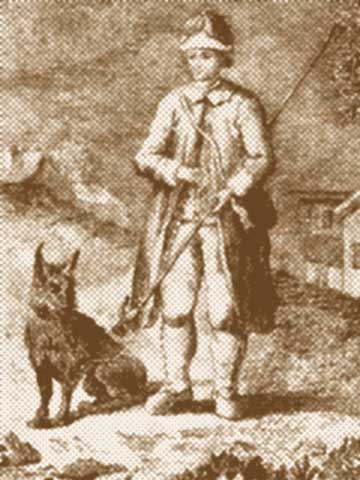
An old woodcut rendition of a French shepherd with his dog
shows a medium-sized dog with prick ears
that resembles the Berger Picard of today.
(Picture in the public domain.)
THE HERDING DOGS OF FRANCE
France is the largest country in Western Europe. The raising of livestock accounts for more than a third of France's agricultural production and there are six million sheep in France today. Many sheep farmers, particularly in the mountainous areas of the Alps in the southeast and the Pyrenees in the southwest, still practice transhumance. France subsidizes transhumance for its ecological value, for as we have seen, transhumance makes the best use of the land, and the animals grazing on the stubble from crops also fertilize the fields without farmers having to resort to man-made inorganic fertilizers which pollute soil and water.
Although France has many herding breeds, I have chosen to present only the medium-sized ones here. Originally, medium-sized dogs were used as herding and farm dogs, and large dogs for livestock guardians, simply because the large dogs could hold their own against large predators. However, in some cases the lines blurred. On transhumance, larger dogs might have been used as drovers' dogs and as flock guardians. French herding dogs that we have not covered in this article are the Beauceron, the Bouvier des Flandres, and the Briard, as they are all larger than medium sized. Perhaps at a later date we will add these three breeds. Furthermore, we fully expect a few more herding dogs to emerge as our research continues, and they will be added when they do.
Crau Shepherd Dog or Chien Berger de Crau
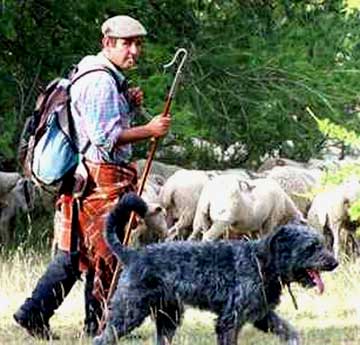 Left, a shepherd in Provençe with his Berger de Crau. (Photo: P. Guiraud, courtesy of Jeanne-Joy Hartnagle-Taylor.)
Left, a shepherd in Provençe with his Berger de Crau. (Photo: P. Guiraud, courtesy of Jeanne-Joy Hartnagle-Taylor.)
Transhumance is a major characteristic of Provençal identity. In Provençe, the Crau Plain has been a continuous link between the Mediterranean basin and the Alps, where every summer since the 16th century, many thousands of sheep passed over the Crau Plain in the Bouches-du-Rhône area of Southern France on their annual trek to higher pastures. Although this link is threatened, the practice of transhumance is still alive on the Crau Plain. Today, most of the transport of sheep is done by truck, but some herds representing about 30,000 sheep, continue to travel by foot.
The Berger de Crau, a hardy dog, independent with a strong character, was once notable on the large migratory treks. They also guarded the flocks. The Crau is a medium-sized, moderately bearded dog with a black curly coat almost like a poodle's, long, naturally bobbed, or docked tail, and flop ears. Pups look like black lambs. It was owned only by sheep farmers and breeding stock was passed from generation to generation. Today, it has largely been replaced by other breeds, the larger and better known Beauceron, for example, or more recently, the Border Collie (some farmers in the area use both the Crau and the Border Collie, and feel that the two breeds complement each other), and farmers are rallying to preserve their breed, of which only a few hundred remain.
In 2010, the Association for the Preservation of the Chien Berger de Crau was formed at the initiative of the Maison de la Transhumance and the Société Centrale Canine (SCC). La Maison is an interpretive center for pastoral cultures of the Mediterranean. It was founded in 2007 by farmers, environmentalists and scientists, and local and cultural officials. Its main objective is education, history, and sharing information and expertise in order to promote biodiversity and sustainable development in the context of transhumant culture. This area of France is already rich in cultural organizations that support pastoralism and La Maison coordinates with them. The SCC, together with the Veterinary School of Maisons-Alfort are conducting a study, preparing a standard, and working towards developing a studbook. The herding characteristics of the breed will be included. Dogs will be microchipped and DNA samples will be taken in order to determine their origin and "purebrededness". Unfortunately, the first time this was done, only 23 individual dogs were identified as purebred Crau. Hopefully more will be in the furture so as not to limit the gene pool so narrowly.
Pyrenean Shepherd or Berger des Pyrénées
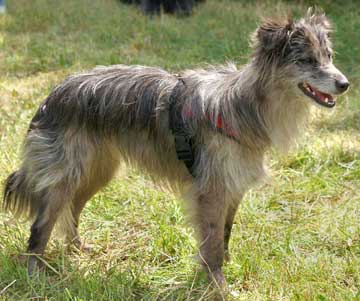 Left, a blue merle Smooth-faced Pyrenean Shepherd. (Photo from Wikipedia where the copyright holder of this work published it under the following license: Permission is granted to copy, distribute and/or modify this document under the terms of the GNU Free Documentation License.)
Left, a blue merle Smooth-faced Pyrenean Shepherd. (Photo from Wikipedia where the copyright holder of this work published it under the following license: Permission is granted to copy, distribute and/or modify this document under the terms of the GNU Free Documentation License.)
This breed, the smallest of the French herding dogs, developed in the French Pyrenees. It comes in two varieties, Smooth-faced (we would simply call it rough-coated) and Rough-faced (which is a bearded-type dog). Interestingly, some Smooth-faced dogs also have slight bearding and a slightly shorter rough coat. They are a medium-sized dog between 15 and 20 inches, males slightly larger than females, and the Rough-faced is generally smaller than the Smooth-faced. Most typical color is fawn (recessive yellow/tan, or sable), with or without a black mask. Brindle, grey, merles, and black, sometimes with white markings, are also seen.
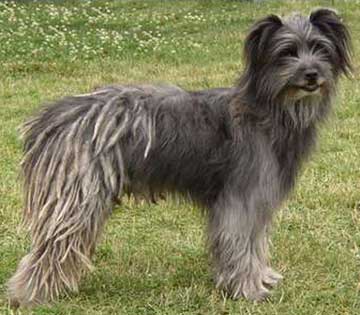 Right, a grey, possibly saddle-patterned Rough-faced Pyrenean Shepherd. Note how the hair on the rear end is corded. Susan Buttivant says that left to its own devices, the hair on the rear end will cord naturally, only on the rough-faced which has a longer coat than the smooth-faced. (Photo courtesy of Susan and Ross Buttivant.)
Right, a grey, possibly saddle-patterned Rough-faced Pyrenean Shepherd. Note how the hair on the rear end is corded. Susan Buttivant says that left to its own devices, the hair on the rear end will cord naturally, only on the rough-faced which has a longer coat than the smooth-faced. (Photo courtesy of Susan and Ross Buttivant.)
According to the Pyrenean Shepherd Club of America, "Its origins lost in the mists of time, the Pyrenean Shepherd has resided in the Pyrenees Mountains of Southern France since time immemorial. Myths abound—that the breed is descended from native Pyrenean bears and foxes; and that this was the original dog of the Cro-Magnon people who painted the cave of Lascaux. What we can know is that bones of small dogs abound in Neolithic sub-fossil deposits, and that sheep and goat herding were so well developed in the Pyrenees that by 6,000 BC, the ecology...had been transformed by overgrazing... Transhumance...has been the mainstay of the economy of the High Pyrenees, and this ancient lifestyle persists even into the twenty-first century. Many Pyr Sheps of excellent type (but with no registered ancestors) still herd sheep every day in the Pyrenees..."
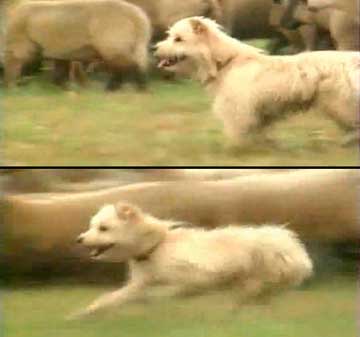 Left, a tiny Smooth-faced Pyrenean Shepherd (remember, they can be as small as fifteen inches) herds sheep. (Photo courtesy of Joni Johnson, from a film.)
Left, a tiny Smooth-faced Pyrenean Shepherd (remember, they can be as small as fifteen inches) herds sheep. (Photo courtesy of Joni Johnson, from a film.)
The breed barks and snaps to control the sheep. They can gather and drive flocks over long, steep distances. When sheep are being moved on the flat and through inhabited areas, the shepherd walks before the flock, and the dogs patrol the flanks with trips to front and rear as needed. Often there is a Great Pyrenees livestock guardian dog with the flock that does not interfere with the herding dogs. The Pyrenean Shepherd can be found today in all dog sports and search-and-rescue, and unfortunately also in show, where their size is increasing and their coats are becoming longer and heavier. It is recognized by the FCI.
Picardie Sheepdog or Berger Picard
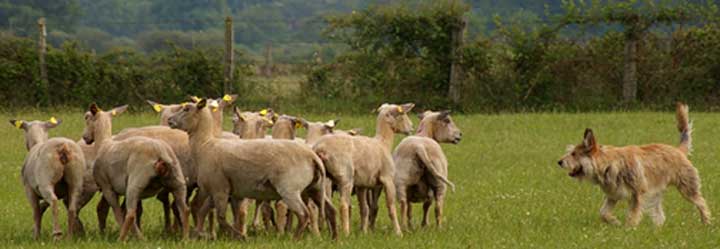
Above, a fawn-colored Berger Picard herding sheep. (Photo courtesy of Francoise Quinton.)
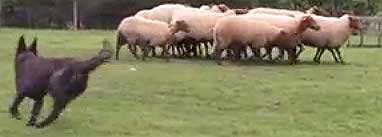 Left, a brindle Picardie.
Left, a brindle Picardie.
Another less-known French herding dog is the Berger Picard, named for the region of Picardie in Northeast France. This breed is on the large side of our chosen subject being between 21 and 25 inches at the shoulder, with males generally larger than females. Still, they are considered a medium-sized dog. They are moderately bearded with a harsh, crisp coat, and prick-eared. They come in two colors, fawn (recessive yellow, tan or sable) and brindle, both with many variations of shade.
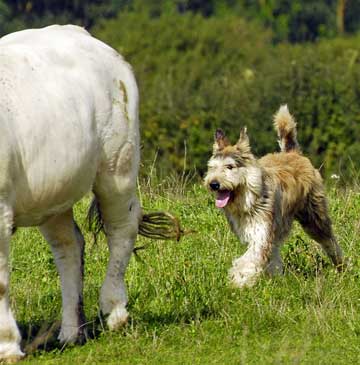 Left, a Picard herding cattle. (Photo courtesy of Jean-Marc Girard.)
Left, a Picard herding cattle. (Photo courtesy of Jean-Marc Girard.)
The Picard is one of the oldest French herding breeds, known since the 9th century when it is thought to have been brought to France by the Franks. Folklore abounds, including that the dog was brought during a Celtic invasion of Gaul around 400 BC (or 800 AD, depending on whom you believe) or that it was brought by Asian tribes invading in the Middle Ages. Its genetic relationship to other French breeds (or Dutch and Belgian breeds, since the breed is said to have developed, if not originated, on the French border with Belgium--see the Bouvier des Ardennes, below) is also a matter of conjecture. Whatever its origin, the Picard does share characteristics with other French and continental breeds. The French grazed their livestock in unfenced fields, and it was necessary for the dogs to keep the flocks out of nearby crops, and move them from pasture to pasture. It is likely that it worked similarly to the Pyrenean Shepherd (above) when working in flat and inhabited areas. It was also required to guard and protect the flock from predators. The Picard works sheep or cattle, but the difference is those that work cattle must be able to utilize a head-bite to get the respect of the herd.
The Picard became a casualty of the two World Wars when its population was decimated and the breed became nearly extinct; and it remains a rare breed today. Numbers are purposely kept small by conscientious breeders, though this may also limit the gene pool. A number of the world's kennel clubs, including French, British, and American, recognize it and it is registered with the FCI. Picards are shown in dog sports today and have appeared in several films in the last few years, most notably Because of Winn-Dixie.
Below, a Picard herding cattle. This is the same dog as the one above left. (Photo courtesy of Jean-Marc Girard.)
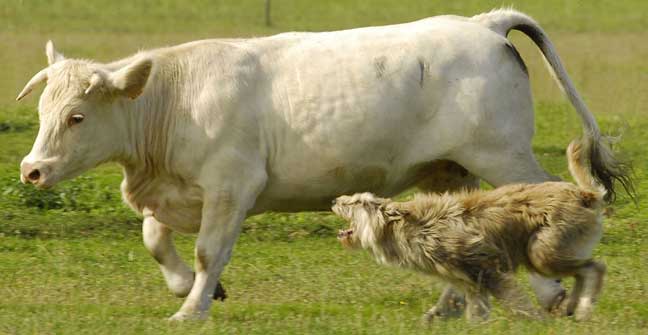
Ardennes Cattle Dog or Bouvier des Ardennes
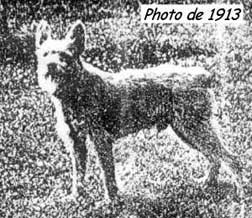 Left, very grainy photo from 1913 shows a Bouvier des Ardennes. Note how much it resembled the Picardy back then. (Photo in the public domain.)
Left, very grainy photo from 1913 shows a Bouvier des Ardennes. Note how much it resembled the Picardy back then. (Photo in the public domain.)
Ardennes is in the northeast of France on the Belgian border. The Bouvier des Ardennes developed in Belgium, or perhaps Belgium was just the first to propose a "standard", but it is claimed as a breed by both Belgium and France and is called "Franco-Belgian" by the FCI. This is a breed that is more similar in looks to the Picard, above, than to its cousin, the Bouvier des Flandres. Some also claim it is the breed from which the Picard developed (or vice versa), but the truth probably is that they both developed from similar local stock.
Below right, a Bouvier des Ardennes today herding sheep. (Photo courtesy of Martina Aufrecht of Schäferei Hollenstein farm in Germany.)
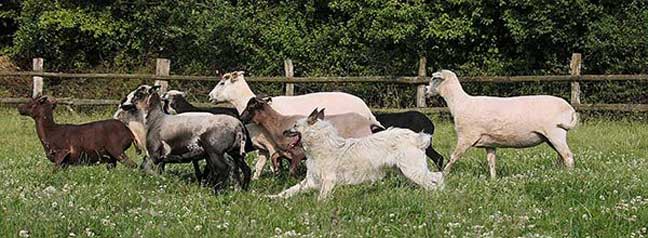
In the past, all cattle-herding dogs in France were called bouvier (bovine-herder or cattle-herder) and, like many other breeds, each area had its own type. The Ardennes was used by cattle drovers and as farm dogs, which made it a tireless and versatile worker. The Ardennes is a medium sized dog. Males are between 22 and 24 inches at the shoulder, females 20 to 22 inches. It is often called the "other Bouvier" or the "small Bouvier", as the Bouvier des Flandres is both better known and larger. Also, the Ardennes has naturaly pricked ears while the Flandres' ears are usually cropped. The Ardennes also has a naturaly bobbed tail. Its coat is short, harsh, and crisp, the coat of a working dog, with slight bearding around the muzzle and eyebrows, and is "allowed" in all colors except white.
As we have seen, many herding dogs were thought to be on the verge of extinction when they were "discovered" by someonein--the Ardennes case someone doing cattle research--and an association was formed to "rescue" the breed. Rescue in this case, as we have seen, has always meant the development of a physical standard, the breeding of a uniform type, and eventually, recognition by the FCI. The Ardennes as a breed is fortunate that its rescuers seemed to have understood that diversity is the real hedge against extinction and that herding ability is more important than looks to a working dog. The Ardennes is still used as a working sheep and cattle dog in France, Belgium, and Germany, perhaps despite it's recognition by the FCI.
This is the same dog as the one above. (Photo courtesy of Martina Aufrecht of Schäferei Hollenstein farm in Germany.)
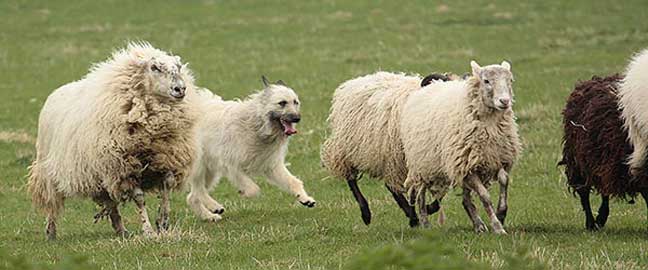
Savoyard Shepherd Dog or Berger du Savoie
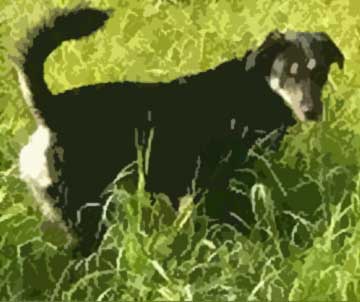
Above, a black-and-tan Savoyard.
(Original photo courtesy of Francis Vandersteen of Groupe Milouchouchou
(www.milouchouchou.com).)
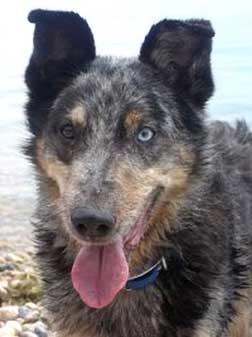 Right, a blue merle Savoyard with one blue eye.
Right, a blue merle Savoyard with one blue eye.
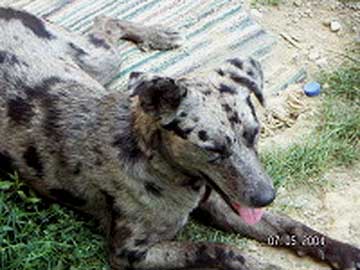 Left, another blue merle.
Left, another blue merle.
The Savoyard is an Alpine breed from Savoy in the southeast of France. As I put these articles together, dogs were coming out of the woodwork. The Savoyard was one of them. It is a medium-sized dog, used as a herder and guardian. It is one of the less-known French herding breeds and is endangered. It is not registered with the FCI.
There is little information available on the Savoyard. It is described as a guardian/mastiff/molosser-type but more resembles the other Alpine herding breeds. It is an old type that was once widely used on dairy farms throughout Savoy, but not elsewhere. It herds sheep, cattle, and goats, and guards the herds and homestead. It was also used to pull carts and sleds to transport milk. The Berger de Savoie is about 21 inches at the shoulder and has a smooth or moderate rough coat. Like other Alpine breeds it comes in merle (blue, slate, or red), but also comes in sable, black-and-tan and tricolor.
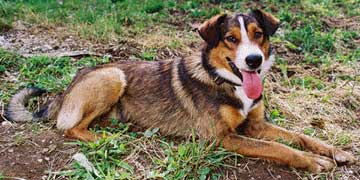 A sable Savoyard. (Photo from Vos Chiens magazine courtesy of Jeanne Joy Hartnagle-Taylor, Stockdog Savvy (stockdogsavvy.wordpress.com/).)
A sable Savoyard. (Photo from Vos Chiens magazine courtesy of Jeanne Joy Hartnagle-Taylor, Stockdog Savvy (stockdogsavvy.wordpress.com/).)
Today its numbers are few, and in 2002 farmers and veterinarians came together to form the Société du Berger de Savoie to develop a standard (uh-oh) and help the breed recover.
Resources:
American Rare Breed Association (www.arba.org/Bouvier_de_Ardennes.htm).
Les Amis du Berger Picard (www.berger-picard.fr).
Articles de Milouchouchou (www.milouchouchou.com/articles/les-races-de-chiens_rares/berger-de-savoie/berger-de-savoie-68-thread.html).
Berger Picard Club of America (http://picards.us/).
Bouvier des Ardennes (www.bouvier-des-ardennes.de).
Club Franćais du Bouvier des Ardennes (www.club-bouvier-des-flandres.net/bouvier-des-ardennes.php).
Engel, Jim. "The Bouvier Des Ardennes" (http://angelplace.net/CentauriKennel/Centauri/BookForm.htm).
La Société du Berger de Savoie (www.bergerdesavoie.org/).
Pyrenean Shepherd Club of America (www.pyrshepclub.com/pyrshephistory.html).
Wikipedia (www.en.wikipedia.org/wiki/Berger_Picard).
Wikipedia (www.en.wikipedia.org/wiki/Bouvier_des_Ardennes).
Copyright © 2013 by Carole L. Presberg
Return to
![]()
BORDER COLLIE COUSINS
THE OTHER WEB PAGES WE MAINTAIN
These web pages are copyright ©2013
and maintained by webmeistress Carole Presberg
with technical help from webwizard David Presberg
ALL RIGHTS RESERVED
If you are interested in using ANY material on this website, you MUST first ask for permission.